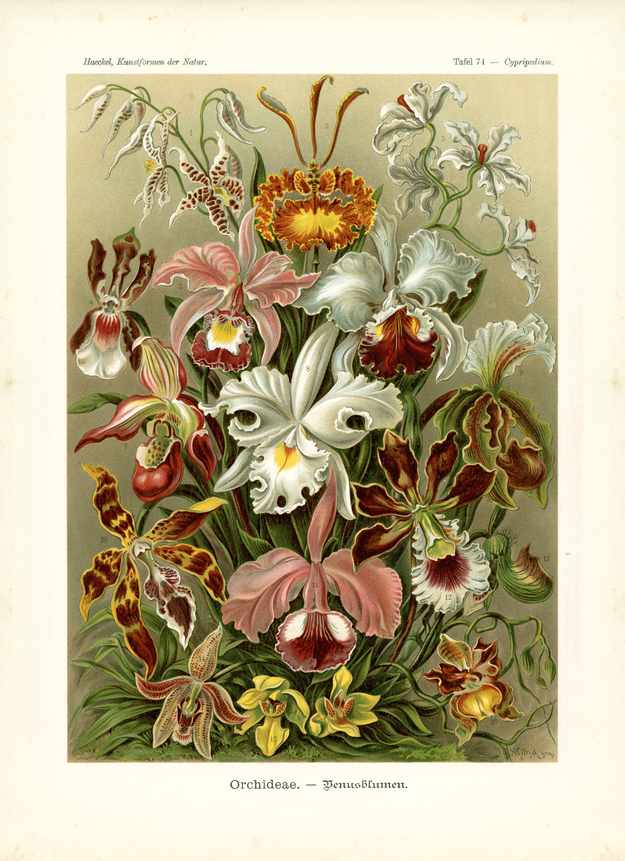Translation of the original German introduction by Ernst Haeckel:
Division of Phanerogamae or Anthophyta (Blumenpflanzen); - main class of Angiospermae (Decksamige); - class of Monocotylae (Einsamenlappige); - legion of Gynandrae (Säulengriffel); - family of Orchideae (Venusblumen or Kuckucksblüten).
Orchids or “flower of Venus” take a leading position among the Monocotylae or “single-seed-loped” for their beautiful and varied “art forms” of the flower, just as Papilionacea or “butterfly flowers” hold the top of the Dicotylae or “two-seed-loped”. In both highly variable families the multi-shaped flower is distinguished by a bilateral basic form (bilateral, dorsiventral or cygomorph basic form): it differentiates between a right and a left side as well as a back and a front side. In both families this bilateral, symmetric basic form of the flower evolves out of a radial-regular form or a primary-radial form through secondary adaptation having been tri-radial in Monocotylae, penta-radial in Dicoltylae. The tri-radial-bilateral flower of orchids derives from the tri-radial-regular flower of certain lily-like Amaryllideae (with five trimerous ‘leaf-circles’); similarly the penta-radial-bilateral flower of Papilionaceae from the penta-radial-regular flower of a certain rose-like Rosaceae (with five pentamerous ‘leaf-circles’). In both families the flower is an upper-continuous one (above the ovary), and one single, median petal leaf is distinguished by its particular size, shape as well as colouration: in orchids it is called ‘honey-lip’ (Labellum), in Papilionaceae ‘banner’ (Vexillum). In both families this peculiar frame of the flowers is due to adaptation to insemination through insects; the original shape conferred from the ancestry through inheritance is blurred.
At the same time, natural selection has determined the structure of the insects facilitating insemination, thus the striking similarity between these cygomorph flowers with bees and bumblebees, flies and butterflies. In a similar way and entirely satisfactory selection theory explains the peculiar and endlessly manifold formations of individual flower parts caused by mutual adaptation of flowers and insects that inseminate them; a significant part is played here by mimetic adaptation and attraction of flying insects which happens with the help of conspicuous shape and excessive colouration of the flowers. Attracted by the sweet ‘honey-juice’ at the base of the blossom bees, flies, butterflies etc. search for this juice, in the process wipe dust or pollen from the stamen and carry it over to the next flower visited. In this way the unfavourable self-fertilisation of flowers is limited, favourable cross-pollination facilitated. With more than 6000 known living species of Orchideae and more than 5000 species of Papilionaceae, and with a still bigger number of species in closest relation with them the extraordinary multiplicity of their striking flower-shapes can easily be explained.
Orchids of temperate regions are in most cases represented as smaller, terricolous varieties whereas in hot climate zones a much larger number of impressive, mostly epithytic species are found. Our plate illustrates a selection of the latter species in natural size. The six petals of the colourful bloom-cover are grouped in two circles in such a way that the three smaller and more slender leaves of the outer circle recede; of the three bigger, usually more broad leaves of the inner circle the two lateral ones are developed in a pair; the ‘un-paired’ intermediate leaf (originally dorsal, in the centre of the dorsum) forms the huge and beautiful ‘honey-lip’ (Labellum). Opposite to it, in the centre of the front side of the column (Columna), the characteristic flower part of orchids is seen, coming into being through connation of the female pistil with the male filaments (therefore the old name of the class: Gynandria = ‘female-male’ for the ‘close’ hermaphroditic orchids). Usually only one of the six filaments (three inner and three outer) is developed, the ventral or ‘venter-stand’ of the outer circle; its anther rests on the top of the column, above the stigma. The special formation of these two most important sexual organs, the male stamen and the female pistil shows that selection has brought about a plethora of suitable provisions in the course of time.
Translation by VR Translators Bangalore
We've scanned the original lithography at 1200dpi on the Epson A3 scanner of A3 scanner huren. You can download a 400dpi JPEG here.
